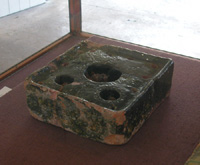 |
 |
 |
 |
 |
 |
 |
|
Byland Abbey: History
Byland Abbey: Buildings
|
The chapter meeting After the necessary disciplinary measures had been taken, business matters were discussed. Announcements were made, letters read out, officials appointed and novices or lay-brothers professed. On certain feast days a sermon was given and on such occasions the lay-brothers might join the monks in the chapter-house. If there was a shortage of space, the lay-brothers were expected to listen at the door.(29) At the close of the chapter meeting the monks stood facing eastwards for the recitation of Psalm 129 (De Profundis) and prayers.(30)
The community welcomed distinguished visitors in the chapter-house, such as royalty and prelates, who received the blessing, heard a reading and might then address the community.(31) Whereas those conducting a visitation of the abbey would have read out their injunctions in the chapter-house, benefactors formalised their grants here or were received into the confraternity of the house. It was in the chapter-house at Byland – as at other religious houses in England and Wales – that the community gathered for the last time and surrendered its abbey to Henry VIII’s commissioners. The inkwell that was recovered here in 1924 may well have been that used by the community on this momentous occasion. Unusual and important finds were made when the chapter-house was excavated in 1924. These included a twelfth-century lectern base, which is the only surviving example of its kind in the country and is now on display in the visitors ’ centre at the site. |
